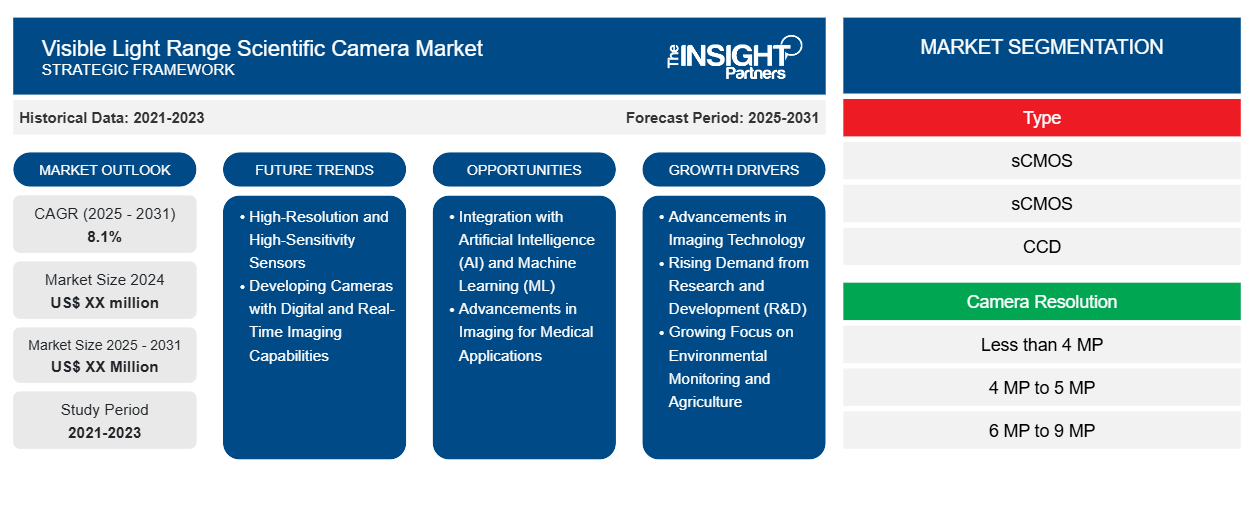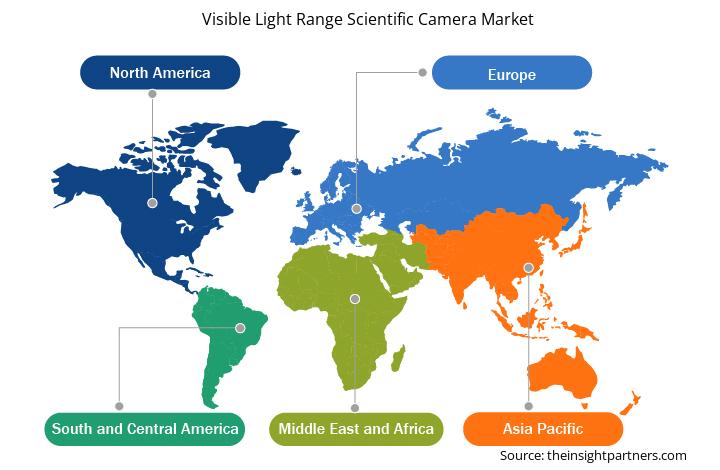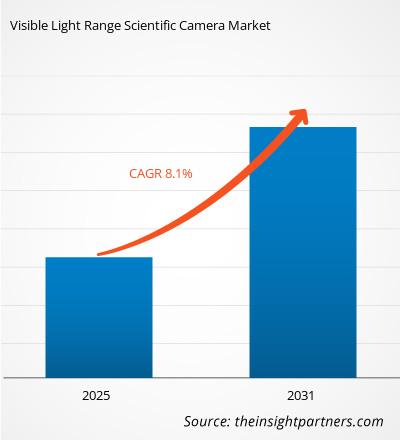可见光范围科学相机市场预计在 2025 年至 2031 年期间的复合年增长率为 8.1%,市场规模将从 2024 年的 XX 百万美元扩大到 2031 年的 XX 百万美元。
该报告按类型(sCMOS、sCMOS(背照式)、CCD、CCD(背照式)、EMCCD)细分;相机分辨率(小于 400 万像素、400 万像素至 500 万像素、600 万像素至 900 万像素和大于 900 万像素)细分。全球分析进一步细分为区域和主要国家。报告提供了上述分析和细分市场的美元价值。
报告目的
Insight Partners 发布的《可见光范围科学相机市场》报告旨在描述可见光范围科学相机市场的现状和未来增长、主要驱动因素、挑战和机遇。这将为各业务利益相关者提供见解,例如:
- 技术提供商/制造商:了解不断变化的市场动态并了解潜在的增长机会,使他们能够做出明智的战略决策。
- 投资者:对市场增长率、市场财务预测以及整个价值链中存在的机会进行全面的趋势分析。
- 监管机构:规范市场政策和警察活动,旨在最大限度地减少滥用行为,维护投资者的信任和信心,维护市场的完整性和稳定性。
可见光范围科学相机市场细分
类型
- CMOS
- CMOS
- 电荷耦合器件
- 电荷耦合器件
- EMCCD
相机分辨率
- 少于 4 MP
- 400 万像素至 500 万像素
- 600 万像素至 900 万像素
- 超过 9 MP
定制此报告以满足您的要求
您可以免费定制任何报告,包括本报告的部分内容、国家级分析、Excel 数据包,以及为初创企业和大学提供优惠和折扣
可见光范围科学相机市场:战略洞察

- 获取此报告的顶级关键市场趋势。此免费样品将包括数据分析,从市场趋势到估计和预测。
可见光范围科学相机市场增长动力
- 成像技术的进步:CMOS(互补金属氧化物半导体)和CCD(电荷耦合器件)等传感器技术的日益复杂化是关键驱动因素。这些传感器提供更高的分辨率、更高的灵敏度和更高的效率,从而能够在广泛的应用领域实现更高质量的成像。背照式传感器和更高的像素密度等创新技术提升了可见光相机的性能,使其在科学应用领域更具吸引力。CMOS (complementary metal-oxide-semiconductor) and CCD (charge-coupled device) is a key driver. These sensors offer better resolution, enhanced sensitivity, and greater efficiency, allowing for higher-quality imaging across a wide spectrum of applications. Innovations like back-illuminated sensors and increased pixel density have improved the performance of visible light cameras, making them more attractive for scientific use.
- 研发 (R&D) 需求不断增长:大学、研究机构和企业研发部门越来越依赖高质量的科学成像进行实验。这涵盖了生物、化学、物理、材料科学和环境研究等领域的应用。为了分析样本、检测细微变化或观察现象,需要精细、精确的图像,这推动了对可见光范围相机的需求。
- 环境监测和农业日益受到关注:可见光范围内的相机在环境科学、农业和生态学等领域发挥着至关重要的作用。清晰的成像技术有助于监测生态系统、天气模式和农作物,从而分析植物健康状况、检测环境变化或进行土地测绘。对精确环境数据日益增长的需求正在推动这些领域的市场扩张。
可见光范围科学相机市场未来趋势
- 高分辨率和高灵敏度传感器:一个主流趋势是对能够捕捉精细细节的高分辨率相机的需求日益增长。在天文学、材料科学和生物医学研究等领域,捕捉高分辨率图像的能力至关重要。对弱光具有高灵敏度的相机(通过低噪声传感器等技术)的需求日益增长,因为它可以在昏暗的环境中实现更清晰的成像。
- 开发具有数字和实时成像功能的相机:数字成像解决方案和实时图像处理的趋势十分显著。许多行业,尤其是医疗诊断和工业检测,都需要来自科学相机的实时反馈。这能够加快决策速度,并对观察到的现象做出更即时的反应,而这一趋势正受到更快处理器和更高效图像传感器发展的推动。
可见光范围科学相机市场机遇
- 与人工智能 (AI) 和机器学习 (ML) 的集成:可见光相机与人工智能 (AI) 和机器学习 (ML) 算法的结合正在开辟新的机遇。这些技术可以增强图像处理和分析能力,从而实现更快、更准确的结果,例如自动识别大型数据集中的模式或异常。人工智能增强型相机在医疗保健(医学成像)和工业检测领域尤其有益,因为在这些领域,检测细微变化至关重要。
- 医疗成像应用的进步:随着对非侵入式诊断工具的需求不断增长,可见光相机在医疗领域迎来了发展机遇。内窥镜、显微镜和皮肤科成像等应用越来越多地使用高清可见光相机进行详细诊断。集成先进光学元件和精确照明系统的相机对于改善患者治疗效果至关重要。
可见光范围科学相机市场区域洞察
Insight Partners 的分析师已详尽阐述了预测期内可见光范围科学相机市场的区域趋势和影响因素。本节还讨论了北美、欧洲、亚太地区、中东和非洲以及南美和中美洲的可见光范围科学相机市场细分和地域分布。

- 获取可见光范围科学相机市场的区域特定数据
可见光范围科学相机市场报告范围
| 报告属性 | 细节 |
|---|---|
| 2024年的市场规模 | XX百万美元 |
| 2031年的市场规模 | XX百万美元 |
| 全球复合年增长率(2025-2031) | 8.1% |
| 史料 | 2021-2023 |
| 预测期 | 2025-2031 |
| 涵盖的领域 | 按类型
|
| 覆盖地区和国家 | 北美
|
| 市场领导者和主要公司简介 |
|
可见光范围科学相机市场参与者密度:了解其对业务动态的影响
可见光科学相机市场正在快速增长,这得益于终端用户需求的不断增长,而这些需求的驱动因素包括消费者偏好的演变、技术进步以及对产品优势的认知度的提升。随着需求的增长,企业正在扩展产品线,不断创新以满足消费者需求,并抓住新兴趋势,从而进一步推动市场增长。
市场参与者密度是指特定市场或行业内企业或公司的分布情况。它表明特定市场空间内竞争对手(市场参与者)的数量相对于其规模或总市值而言。
在可见光范围科学相机市场运营的主要公司有:
- 滨松光子学
- 泰莱达因技术公司
- Thorlabs公司
- XIMEA有限公司
- 光子科学
- Excelitas PCO有限公司
免责声明:以上列出的公司没有按照任何特定顺序排列。

- 获取可见光范围科学相机市场顶级关键参与者概览
主要卖点
- 全面覆盖:报告全面涵盖可见光范围科学相机市场的产品、服务、类型和最终用户的分析,提供整体概况。
- 专家分析:本报告基于对行业专家和分析师的深入了解而编写。
- 最新信息:该报告涵盖了最新信息和数据趋势,确保了业务相关性。
- 定制选项:此报告可以定制以满足特定客户要求并适合业务策略。
因此,这份关于可见光范围科学相机市场的研究报告,有助于引领我们解读和理解行业现状及增长前景。尽管存在一些合理的担忧,但本报告的总体优势往往大于劣势。
- 历史分析(2 年)、基准年、预测(7 年)及复合年增长率
- PEST和SWOT分析
- 市场规模、价值/数量 - 全球、区域、国家
- 行业和竞争格局
- Excel 数据集
近期报告
相关报告
客户评价
购买理由
- 明智的决策
- 了解市场动态
- 竞争分析
- 客户洞察
- 市场预测
- 风险规避
- 战略规划
- 投资论证
- 识别新兴市场
- 优化营销策略
- 提升运营效率
- 顺应监管趋势




















 获取免费样品 - 可见光范围科学相机市场
获取免费样品 - 可见光范围科学相机市场